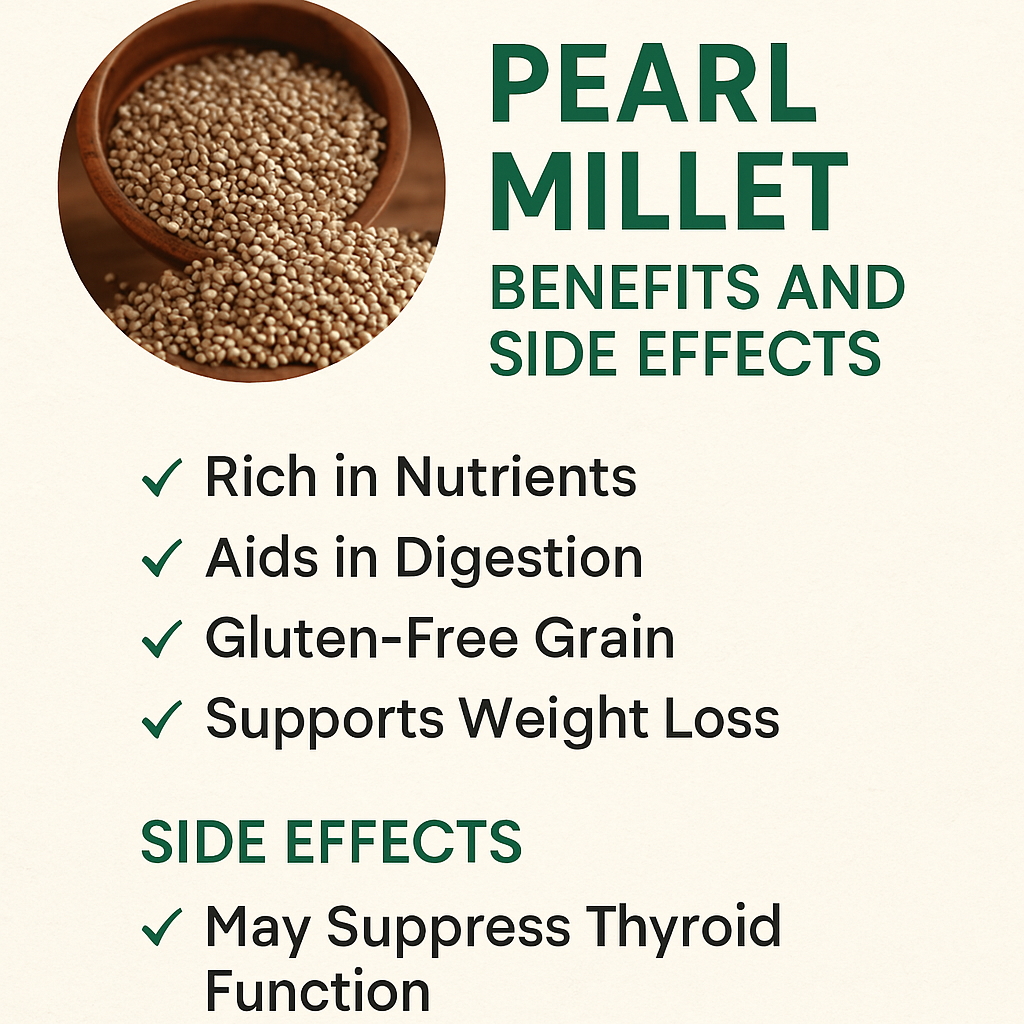Pearl millet, commonly known as Bajra in Hindi and Sajjalu in Telugu, is one of the most ancient and resilient grains cultivated in India and Africa. With a slightly nutty taste and coarse texture, it’s gaining popularity once again in health-conscious households thanks to its amazing health benefits.
Let’s dive into the nutritional powerhouse that is pearl millet — its benefits, possible side effects, and why it’s a smart addition to your diet.
✅ Health Benefits of Pearl Millet
1. Rich in Nutrients
Pearl millet is loaded with essential nutrients like:
Iron
Magnesium
Phosphorus
Potassium
Protein
Fiber
Vitamin B-complex
These nutrients play a vital role in maintaining energy levels, bone strength, and brain function.
2. Aids in Digestion
High in dietary fiber, pearl millet supports healthy digestion. It prevents constipation, improves bowel movement, and promotes gut health. This makes it especially good for people with sluggish digestion or irritable bowel syndrome (IBS).
3. Gluten-Free Grain
Bajra is naturally gluten-free, making it an excellent alternative for people with celiac disease or gluten intolerance. It’s easy on the stomach and ideal for those following a gluten-free diet.
4. Supports Weight Loss
Due to its high fiber and complex carbohydrate content, pearl millet provides long-lasting satiety. It keeps you full for longer, preventing unhealthy snacking and aiding in weight management.
5. Good for Diabetics
Pearl millet has a low glycemic index, meaning it releases sugar slowly into the bloodstream. This helps in:
Managing blood sugar levels
Preventing insulin spikes
Reducing the risk of Type 2 diabetes
6. Boosts Heart Health
Thanks to its magnesium and potassium content, pearl millet helps:
Lower blood pressure
Reduce bad cholesterol
Improve overall cardiovascular health
7. Improves Skin & Hair Health
Rich in antioxidants and essential amino acids, Bajra supports healthy skin regeneration and strengthens hair. Regular consumption can lead to improved skin texture and reduced hair fall.
8. Enhances Immunity
Pearl millet is a good source of zinc and iron, both crucial for building a strong immune system. This is especially important during seasonal changes and times of illness.
⚠️ Possible Side Effects of Pearl Millet
Though pearl millet is generally safe, excessive or improper consumption can cause some issues:
1. Thyroid Suppression (Goitrogens)
Pearl millet contains goitrogens, substances that can interfere with thyroid function when consumed in excess. People with hypothyroidism should limit intake or consult a doctor.
🔎 Tip: Toasting or cooking bajra thoroughly can help reduce goitrogens.
2. May Cause Bloating or Gas
Due to its high fiber, some people may experience bloating or gas, especially if they’re not used to high-fiber diets.
🔄 Start with small portions and gradually increase intake.
3. Not Ideal for Infants
Because of its dense, fibrous nature, it’s not recommended for babies under 1 year unless it’s part of a well-balanced puree or porridge.
📊 Nutritional Value of Pearl Millet (Per 100g raw)
| Nutrient | Value |
|---|---|
| Calories | 361 kcal |
| Protein | 11.6 g |
| Carbohydrates | 67 g |
| Dietary Fiber | 8.5 g |
| Fat | 5 g |
| Iron | 8 mg |
| Magnesium | 137 mg |
| Calcium | 42 mg |
| Potassium | 300 mg |
| Phosphorus | 296 mg |
🍽️ How to Include Pearl Millet in Your Diet
Bajra Roti – Pair with curd or curry for a balanced meal
Bajra Khichdi – A wholesome one-pot dish
Bajra Dosa – Great gluten-free breakfast option
Bajra Ladoo – A healthy sweet with jaggery and ghee
Bajra Porridge – Perfect for babies and the elderly
🛒 Where to Buy Pearl Millet
Pearl millet is available:
At local grocery stores
Organic stores like Organic India, 24 Mantra
Online platforms: Amazon, BigBasket, Flipkart
Look for:
Whole grains
Pearl millet flour
Pre-mixed bajra rotis or dosa batter
❓ FAQs
Q: Is pearl millet suitable for daily use?
A: Yes, when consumed in moderation and as part of a balanced diet, it is very healthy.
Q: Can I eat pearl millet at night?
A: It’s best consumed during the day or at lunch. Being heavy, it may cause discomfort at night.
Q: Is bajra better than wheat?
A: Bajra has higher fiber and iron content compared to wheat, and is gluten-free. However, wheat has more gluten and is easier to digest for some.
🌟 Final Thoughts
Pearl millet is a nutritional powerhouse that’s perfect for modern, health-conscious diets. Whether you’re looking to manage weight, improve digestion, or just explore traditional Indian grains, Bajra has a lot to offer.
But remember — moderation is key, especially if you have thyroid concerns or digestive issues.

